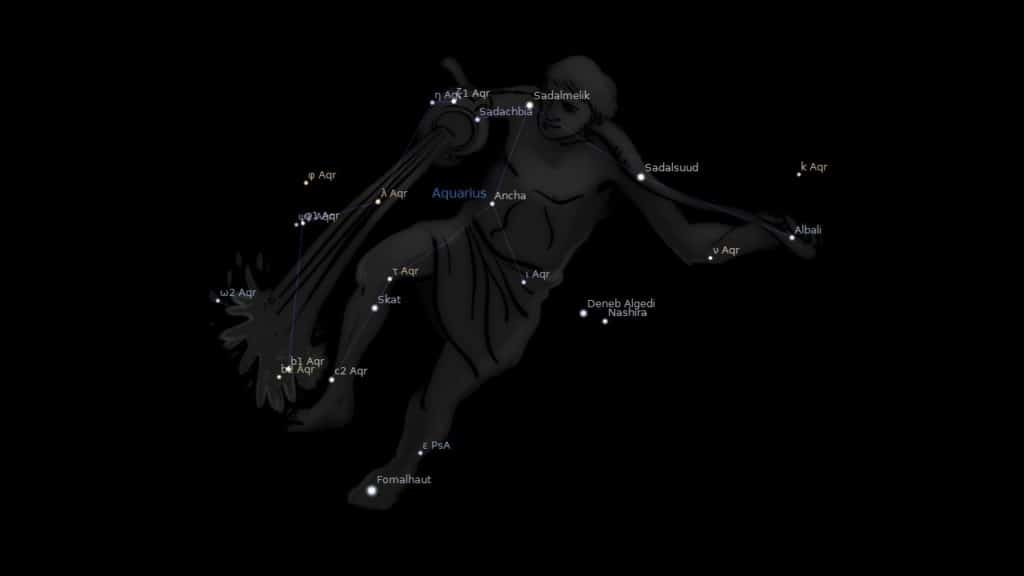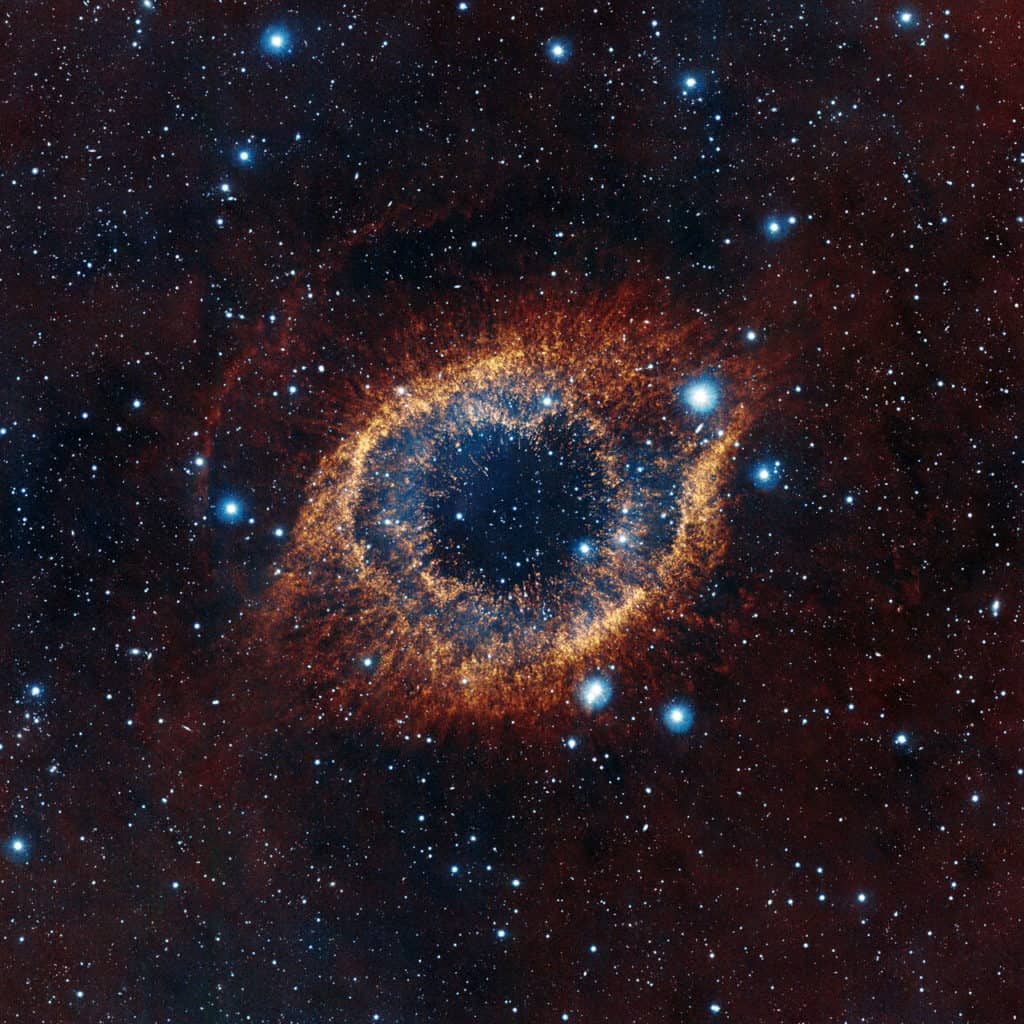Sadalsuud, designated as Beta Aquarii, is the brightest star in the zodiacal constellation of Aquarius. It has an apparent magnitude of 2.87, slightly surpassing Sadalmelik / Alpha Aquarii, which is at magnitude 2.94.
Key Facts & Summary
- Sadalsuud is located at around 540 light-years / 165 parsecs away from our Solar System.
- It has an apparent magnitude of 2.87, and an absolute magnitude of -3.04.
- Sadalsuud appears as a single star to the naked eye, however, it has two optical companions. They are much fainter, distant, smaller, and don’t appear to be gravitationally bound with Sadalsuud.
- Sadalsuud is a yellow supergiant star of spectral type G0 lb.
- Its spectrum has served as one of the stable anchor points by which other stars have been classified, since 1943.
- Sadalsuud has 4.97 solar masses, and 47.88 solar radii, thus it is around 100 times bigger than our Sun.
- This star is also very bright, being 2,046 times brighter than our Sun.
- Sadalsuud has however similar temperatures to our Sun, being slightly cooler, at 5,608 K.
- The surface gravity on this star has been recorded at around 2.05 cgs.
- Sadalsuud has a radial velocity of 6.5 km / 4.0 mi per second, while its rotational velocity is 6.3 km / 3.9 mi per second.
- This star is 110 million years old. It is much younger than our Sun.
- Sadalsuud appears to be an X-ray source. It is among the first G-type supergiant stars to have its X-rays detected.
- The zodiacal constellation of Aquarius is among the oldest in the sky. It was listed among the first 48 Greek constellations in Ptolemy’s 2nd century Almagest.
- Aquarius is now among the 88 modern constellations, being the 10th largest in the sky, stretching for around 980 square degrees.
- The best time to observe Sadalsuud, the other stars, and deep-sky objects in Aquarius, is during the month of October.
β Aquarii
Beta Aquarii bears the traditional name Sadalsuud, which comes from an Arabic expression “sa’d al-su’ud” – which means “luck of lucks”. Some other variants include Sad es Saud, Sadalsund, or Saad el Sund.

In the catalog of stars in the Calendarium of Al Achsasi Al Mouakket, Beta Aquarii was known as Nir Saad al Saaoud, which was translated from Latin as Lucida Fortunae Fortnunarum – “the brightest of luck of lucks”. The IAU approved the name Sadalsuud for Beta Aquarii in late 2016.
Formation
Sadalsuud formed around 110 million years ago from a rich interstellar medium of gas and dust. Gravity pulled the swirling gas and dust together and resulted in the brightest star in Aquarius, Sadalsuud. The two optical companions around Sadalsuud appear to have different motions, thus they aren’t believed to share a common origin with Sadalsuud.
Distance, Size, and Mass
Sadalsuud is located at around 540 light-years / 165 parsecs away from our Solar System. It is visible to the naked eye, and when viewed through telescopes, two faint visual companions appear “near” it.

Sadalsuud has around 4.97 solar masses, or 497% of our Sun’s mass, and 47.88 solar radii, or 4,788% of our Sun’s radius. It is thus around 100 times bigger than our Sun.
Other Characteristics
Sadalsuud / Beta Aquarii is a yellow supergiant star of spectral type G0 lb. It is 2,046 times brighter than our Sun, having an apparent magnitude of 2.87, and an absolute magnitude of -3.04.
Sadalsuud is around 100 K cooler than our Sun, having surface average temperatures of around 5,608 K. The star’s corona is also a known X-ray emitter.

The Chandra X-ray Observatory reported X-rays being emitted from this star. It is among the first supergiant G-type stars to have its X-rays detected.
Sadalsuud’s spectrum has served as one of the stable anchor points by which other stars are classified since 1943. This star has a radial velocity of 6.5 km / 4.0 mi per second, while its rotational velocity is 6.3 km / 3.9 mi per second. The surface gravity on this star has been recorded at around 2.05 cgs.
Star System
Sadalsuud appears to have two faint optical companions, however, it is unknown if they are gravitationally bound with Sadalsuud. They also have a different proper motion, meaning they most likely don’t share a common origin with the supergiant.

One of the companions is an 11th magnitude star that was discovered in 1947. It is separated from Sadalsuud / Beta Aquarii by around 35.4 arcseconds.
The secondary companion has a magnitude of 11.6, its position angle being 186 degrees with a separation from Sadalsuud of 57.2 arcseconds.
Location
Sadalsuud / Beta Aquarii is located in the zodiacal constellation of Aquarius, the celestial water-carrier, or cup-carrier. It is the brightest star in the constellation.
Sadalsuud has an apparent magnitude of 2.87, slightly surpassing Sadalmelik / Alpha Aquarii, which is at magnitude 2.94. Both stars are luminous yellow supergiants and they move through space perpendicular to the plane of our Milky Way Galaxy.

The constellation of Aquarius is among the oldest of the recognized constellations of the zodiac – the Sun’s apparent path. Aquarius was one of the 48 constellations first listed by the 2nd-century astronomer, Ptolemy. It remains among the 88 modern constellations.
The constellation of Aquarius is found in a region often called the Sea – due to its profusion of constellations with watery associations such as Cetus the whale, Pisces the fish, and Eridanus the river. Aquarius is the 10th largest constellation in the sky, spreading out over 980 square degrees. This constellation can be seen in the spring in the Southern Hemisphere and during fall in the Northern Hemisphere.

The constellation of Aquarius hosts a couple of interesting stars, and deep-sky objects, such as the globular cluster Messier 2, Messier 72, and the open cluster Messier 73. There are two famous planetary nebulae in Aquarius, the Saturn Nebula (NGC 7009) and the Helix Nebula (NGC 7293). The two brightest stars in Aquarius, Alpha Aquarii, and Beta Aquarii are luminous yellow supergiants, of spectral types G0lb and G2lb.
The top 10 brightest stars in Aquarius are 1.Beta Aquarii / Sadalsuud – apparent magnitude 2.8, Alpha Aquarii / Sadalmelik – apparent magnitude 2.9, Delta Aquarii / Skat – apparent magnitude 3.3, Zeta Aquarii – apparent magnitude 3.65, Lambda Aqaurii / Hydor – apparent magnitude 3.72, Epsilon Aquarii / Albali – apparent magnitude 3.77, Gamma Aquarii / Sadachbia – apparent magnitude 3.8, Theta Aquarii / Ancha – apparent magnitude 4.1, Pi Aquarii / Seat – apparent magnitude 4.57, and Xi Aquarii / Bunda – apparent magnitude 4.7

The best time of the year to observe Sadalsuud, the other stars and deep-sky objects in the constellation of Aquarius, is during the month of October when the constellation is the most prominent in the sky.
The Future
Sadalsuud was most likely a hot B-type main-sequence star, before evolving into a supergiant. Though the star is young, it has transcended its stellar evolution very fast.
Sadalsuud will continue to live for millions of years, however, it will one day evolve into a white dwarf star, since it isn’t massive enough to explode as a supernova.
Did you know?
- The Chinese know Beta Aquarii as Xu Su yi – the First Star of Emptiness, which refers to a Chinese asterism named Xu Su – Emptiness – which is composed out of Beta Aquarii and Alpha Equuilei.
- In the Hindu texts, Sadalsuud is known as Kalpeny, in the context of the ancient Indian system of astronomy, it is located in the 23rd Nakshatra, a lunar mansion which is ruled by Eight vasus – “the deities of earthly abundance”.
- On the Euphrates, Sadalsuud was known as Kakkab Nammax – the Star of Mighty Destiny, that may have given origin to the title of the Manzil, as well as to the astrologers’ name for it – Fortuna Fortunarum,
- In older worldviews (Egyptian, Persian, or Ismalic mythology), Sadalsuud relates to the rising Sun when winter has passed (March), and the season of gentle, continuous rain has begun. Thus the association with the myth of luck or good fortune
- The mythological view of “the luck of the lucks” also belongs to the 22nd Manzil (Arabic Lunar Mansion), which included the two stars Xi Aquarii / Bunda, and 46 Capricorni.
- Beta Aquarii / Sadalsuud, and Xi Aquarii, also constitute the Persian lunar mansion Bunda, and the similar Coptic mansion Upuineuti, the meaning of which is “the Foundation”.
- In Chinese mythology, Sadalsuud marks the sieu (Chinese Lunar Mansion), Heu, Hiu, or Hü – “the Void” – as such, Sadalsuud is an expression of the feminine archetype, the Yin or “Void” (Comic Mother), from which, many cultures have believed, creation itself (birth) emanates.
Sources:
Image sources:
- https://www.astronomytrek.com/wp-content/uploads/2017/06/Sadalsuud-Star.jpg
- https://alchetron.com/cdn/beta-aquarii-71b4d531-0529-4e81-8218-f6138b53826-resize-750.jpg
- https://www.constellation-guide.com/wp-content/uploads/2011/01/Aquarius-Dwarf.jpg
- https://www.astronomytrek.com/wp-content/uploads/2012/11/Aquarius31.jpg
- https://astrologyking.com/wp-content/uploads/constellation-aquarius.jpg
- https://cdn.mos.cms.futurecdn.net/iuQmVPLBRbmRQeoA46VTZ6.jpg
- https://upload.wikimedia.org/wikipedia/commons/thumb/7/74/The_green_bean_galaxy_J2240.jpg/768px-The_green_bean_galaxy_J2240.jpg
